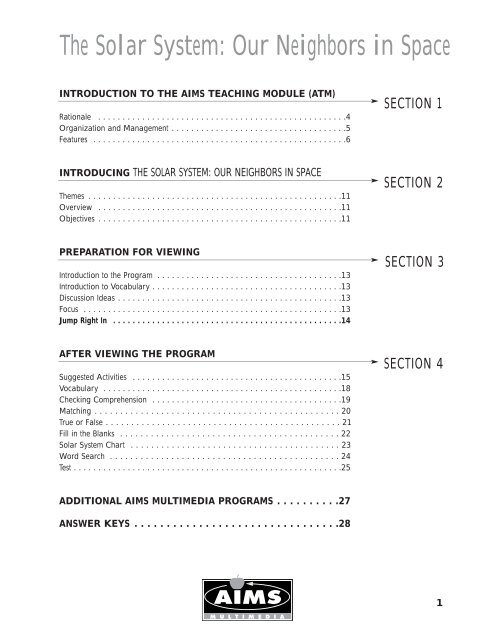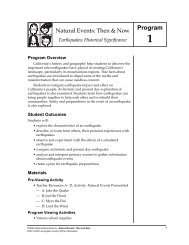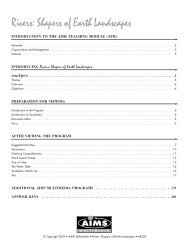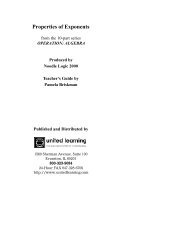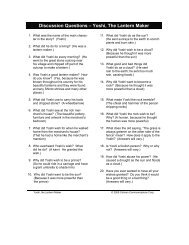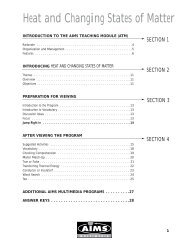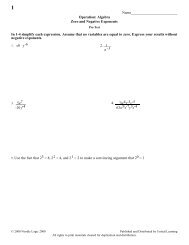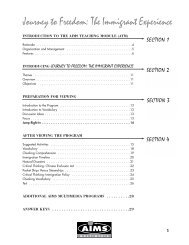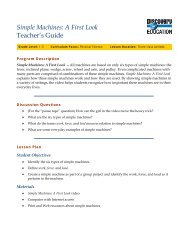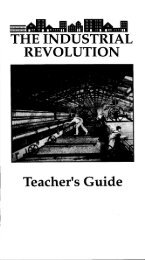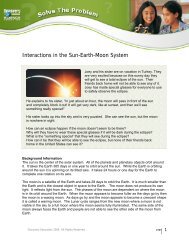ATM-SOLAR SYSTEM - Discovery Education
ATM-SOLAR SYSTEM - Discovery Education
ATM-SOLAR SYSTEM - Discovery Education
Create successful ePaper yourself
Turn your PDF publications into a flip-book with our unique Google optimized e-Paper software.
The Solar System: Our Neighbors in Space<br />
INTRODUCTION TO THE AIMS TEACHING MODULE (<strong>ATM</strong>)<br />
Rationale . . . . . . . . . . . . . . . . . . . . . . . . . . . . . . . . . . . . . . . . . . . . . . . . . . .4<br />
Organization and Management . . . . . . . . . . . . . . . . . . . . . . . . . . . . . . . . . . . .5<br />
Features . . . . . . . . . . . . . . . . . . . . . . . . . . . . . . . . . . . . . . . . . . . . . . . . . . . .6<br />
SECTION 1<br />
INTRODUCING THE <strong>SOLAR</strong> <strong>SYSTEM</strong>: OUR NEIGHBORS IN SPACE<br />
Themes . . . . . . . . . . . . . . . . . . . . . . . . . . . . . . . . . . . . . . . . . . . . . . . . . . . .11<br />
Overview . . . . . . . . . . . . . . . . . . . . . . . . . . . . . . . . . . . . . . . . . . . . . . . . . .11<br />
Objectives . . . . . . . . . . . . . . . . . . . . . . . . . . . . . . . . . . . . . . . . . . . . . . . . . .11<br />
SECTION 2<br />
PREPARATION FOR VIEWING<br />
Introduction to the Program . . . . . . . . . . . . . . . . . . . . . . . . . . . . . . . . . . . . . .13<br />
Introduction to Vocabulary . . . . . . . . . . . . . . . . . . . . . . . . . . . . . . . . . . . . . . .13<br />
Discussion Ideas . . . . . . . . . . . . . . . . . . . . . . . . . . . . . . . . . . . . . . . . . . . . . .13<br />
Focus . . . . . . . . . . . . . . . . . . . . . . . . . . . . . . . . . . . . . . . . . . . . . . . . . . . . .13<br />
Jump Right In . . . . . . . . . . . . . . . . . . . . . . . . . . . . . . . . . . . . . . . . . . . . . . .14<br />
SECTION 3<br />
AFTER VIEWING THE PROGRAM<br />
Suggested Activities . . . . . . . . . . . . . . . . . . . . . . . . . . . . . . . . . . . . . . . . . . .15<br />
Vocabulary . . . . . . . . . . . . . . . . . . . . . . . . . . . . . . . . . . . . . . . . . . . . . . . . .18<br />
Checking Comprehension . . . . . . . . . . . . . . . . . . . . . . . . . . . . . . . . . . . . . . .19<br />
Matching ................................................20<br />
True or False ..............................................21<br />
Fill in the Blanks ...........................................22<br />
Solar System Chart .........................................23<br />
Word Search .............................................24<br />
Test . . . . . . . . . . . . . . . . . . . . . . . . . . . . . . . . . . . . . . . . . . . . . . . . . . . . . . .25<br />
SECTION 4<br />
ADDITIONAL AIMS MULTIMEDIA PROGRAMS . . . . . . . . . .27<br />
ANSWER KEYS . . . . . . . . . . . . . . . . . . . . . . . . . . . . . . . .28<br />
1
© Copyright 1999 AIMS Multimedia<br />
All Rights Reserved. No part of this work may be reproduced or transmitted without written permission of AIMS<br />
Multimedia with these exceptions: Persons or schools purchasing this AIMS Teaching Module may reproduce<br />
consumable <strong>ATM</strong> pages, identified in Section 4, for student or classroom use.<br />
AIMS Multimedia is a leading producer and distributor of educational programs serving schools and libraries for<br />
nearly 40 years. AIMS draws upon the most up-to-date knowledge, existing and emerging technologies, and all of<br />
the instructional and pedagogical resources available to develop and distribute educational programs<br />
in film, videocassette, laserdisc, CD-ROM and CD-i formats.<br />
Persons or schools interested in obtaining additional copies of this AIMS Teaching Module, please contact:<br />
AIMS Multimedia<br />
1-800-FOR-AIMS<br />
1-800-367-2467<br />
2<br />
© Copyright 1999 AIMS Multimedia
Congratulations!<br />
You have chosen a learning program<br />
that will actively motivate your students<br />
AND provide you with easily accessible<br />
and easily manageable instructional<br />
guidelines designed to make your<br />
teaching role efficient and rewarding.<br />
The AIMS Teaching Module provides<br />
you with a video program keyed to your<br />
classroom curriculum, instructions and<br />
guidelines for use, plus a comprehensive<br />
teaching program containing a<br />
wide range of activities and ideas for<br />
interaction between all content areas.<br />
Our authors, educators, and consultants<br />
have written and reviewed the AIMS<br />
Teaching Modules to align with the<br />
Educate America Act: Goals 2000.<br />
This <strong>ATM</strong>, with its clear definition of<br />
manageability, both in the classroom<br />
and beyond, allows you to tailor specific<br />
activities to meet all of your classroom<br />
needs.<br />
© Copyright 1999 AIMS Multimedia<br />
3
RATIONALE<br />
In today’s classrooms, educational pedagogy<br />
is often founded on Benjamin S.<br />
Bloom’s “Six Levels of Cognitive<br />
Complexity.” The practical application<br />
of Bloom’s Taxonomy is to evaluate students’<br />
thinking skills on these levels,<br />
from the simple to the complex:<br />
Knowledge (rote memory skills),<br />
Comprehension (the ability to relate or<br />
retell), Application (the ability to apply<br />
knowledge outside its origin), Analysis<br />
(relating and differentiating parts of a<br />
whole), Synthesis (relating parts to a<br />
whole), and Evaluation (making a judgment<br />
or formulating an opinion).<br />
The AIMS Teaching Module is designed<br />
to facilitate these intellectual capabilities,<br />
AND to integrate classroom experiences<br />
and assimilation of learning<br />
with the students’ life experiences, realities,<br />
and expectations. AIMS’ learner<br />
verification studies prove that our AIMS<br />
Teaching Modules help students to<br />
absorb, retain, and to demonstrate ability<br />
to use new knowledge in their world.<br />
Our educational materials are written<br />
and designed for today’s classroom,<br />
which incorporates a wide range of<br />
intellectual, cultural, physical, and emotional<br />
diversities.<br />
4<br />
© Copyright 1999 AIMS Multimedia
ORGANIZATION AND<br />
MANAGEMENT<br />
To facilitate ease in classroom manageability,<br />
the AIMS Teaching Module is<br />
organized in four sections. You are<br />
reading Section 1, Introduction to the<br />
Aims Teaching Module (<strong>ATM</strong>).<br />
SECTION 2,<br />
INTRODUCING THIS <strong>ATM</strong><br />
will give you the specific information<br />
you need to integrate the program into<br />
your classroom curriculum.<br />
SECTION 3,<br />
PREPARATION FOR VIEWING<br />
provides suggestions and strategies for<br />
motivation, language preparedness,<br />
readiness, and focus prior to viewing<br />
the program with your students.<br />
SECTION 4,<br />
AFTER VIEWING THE PROGRAM<br />
provides suggestions for additional<br />
activities plus an assortment of consumable<br />
assessment and extended activities,<br />
designed to broaden comprehension of<br />
the topic and to make connections to<br />
other curriculum content areas.<br />
© Copyright 1999 AIMS Multimedia<br />
5
FEATURES<br />
INTRODUCING EACH <strong>ATM</strong><br />
SECTION 2<br />
Your AIMS Teaching Module is<br />
designed to accompany a video program<br />
written and produced by some of<br />
the world’s most credible and creative<br />
writers and producers of educational<br />
programming. To facilitate diversity and<br />
flexibility in your classroom, your AIMS<br />
Teaching Module features these components:<br />
Themes<br />
The Major Theme tells how this AIMS<br />
Teaching Module is keyed into the curriculum.<br />
Related Themes offer suggestions<br />
for interaction with other<br />
curriculum content areas, enabling<br />
teachers to use the teaching module to<br />
incorporate the topic into a variety of<br />
learning areas.<br />
Overview<br />
The Overview provides a synopsis of<br />
content covered in the video program.<br />
Its purpose is to give you a summary of<br />
the subject matter and to enhance your<br />
introductory preparation.<br />
Objectives<br />
The <strong>ATM</strong> learning objectives provide<br />
guidelines for teachers to assess what<br />
learners can be expected to gain from<br />
each program. After completion of the<br />
AIMS Teaching Module, your students<br />
will be able to demonstrate dynamic<br />
and applied comprehension of the<br />
topic.<br />
6<br />
© Copyright 1999 AIMS Multimedia
PREPARATION FOR VIEWING<br />
SECTION 3<br />
In preparation for viewing the video<br />
program, the AIMS Teaching Module<br />
offers activity and/or discussion<br />
ideas that you may use in any order<br />
or combination.<br />
Introduction To The Program<br />
Introduction to the Program is<br />
designed to enable students to recall<br />
or relate prior knowledge about the<br />
topic and to prepare them for what<br />
they are about to learn.<br />
Introduction To Vocabulary<br />
Introduction to Vocabulary is a<br />
review of language used in the program:<br />
words, phrases, usage. This<br />
vocabulary introduction is designed to<br />
ensure that all learners, including limited<br />
English proficiency learners, will<br />
have full understanding of the language<br />
usage in the content of the program.<br />
Discussion Ideas<br />
Discussion Ideas are designed to help<br />
you assess students’ prior knowledge<br />
about the topic and to give students a<br />
preview of what they will learn.<br />
Active discussion stimulates interest in<br />
a subject and can motivate even the<br />
most reluctant learner. Listening, as<br />
well as speaking, is active participation.<br />
Encourage your students to participate<br />
at the rate they feel<br />
comfortable. Model sharing personal<br />
experiences when applicable, and<br />
model listening to students’ ideas and<br />
opinions.<br />
Focus<br />
Help learners set a purpose for<br />
watching the program with Focus,<br />
designed to give students a focal<br />
point for comprehension continuity.<br />
Jump Right In<br />
Jump Right In provides abbreviated<br />
instructions for quick management of<br />
the program.<br />
AFTER VIEWING THE PROGRAM<br />
SECTION 4<br />
After your students have viewed the<br />
program, you may introduce any or<br />
all of these activities to interact with<br />
other curriculum content areas, provide<br />
reinforcement, assess comprehension<br />
skills, or provide hands-on<br />
and in-depth extended study of the<br />
topic.<br />
© Copyright 1999 AIMS Multimedia<br />
7
SUGGESTED<br />
ACTIVITIES<br />
The Suggested Activities offer ideas<br />
for activities you can direct in the<br />
classroom or have your students complete<br />
independently, in pairs, or in<br />
small work groups after they have<br />
viewed the program. To accommodate<br />
your range of classroom needs,<br />
the activities are organized into skills<br />
categories. Their labels will tell you<br />
how to identify each activity and help<br />
you correlate it into your classroom<br />
curriculum. To help you schedule your<br />
classroom lesson time, the AIMS<br />
hourglass gives you an estimate of the<br />
time each activity should require.<br />
Some of the activities fall into these<br />
categories:<br />
Meeting Individual<br />
Needs<br />
These activities are designed to aid in<br />
classroom continuity. Reluctant learners<br />
and learners acquiring English<br />
will benefit from these activities<br />
geared to enhance comprehension of<br />
language in order to fully grasp content<br />
meaning.<br />
MATH<br />
Curriculum<br />
Connections<br />
Many of the suggested activities are<br />
intended to integrate the content of<br />
the <strong>ATM</strong> program into other content<br />
areas of the classroom curriculum.<br />
These cross-connections turn the<br />
classroom teaching experience into a<br />
whole learning experience.<br />
Critical Thinking<br />
Critical Thinking activities are<br />
designed to stimulate learners’ own<br />
opinions and ideas. These activities<br />
require students to use the thinking<br />
process to discern fact from opinion,<br />
consider their own problems and formulate<br />
possible solutions, draw conclusions,<br />
discuss cause and effect, or<br />
combine what they already know<br />
with what they have learned to make<br />
inferences.<br />
Cultural Diversity<br />
Each AIMS Teaching Module has an<br />
activity called Cultural Awareness,<br />
Cultural Diversity, or Cultural<br />
Exchange that encourages students to<br />
share their backgrounds, cultures,<br />
heritage, or knowledge of other countries,<br />
customs, and language.<br />
Hands On<br />
These are experimental or tactile<br />
activities that relate directly to the<br />
material taught in the program.Your<br />
students will have opportunities to<br />
make discoveries and formulate ideas<br />
on their own, based on what they<br />
learn in this unit.<br />
Writing<br />
Every AIMS Teaching Module will<br />
contain an activity designed for students<br />
to use the writing process to<br />
express their ideas about what they<br />
have learned. The writing activity<br />
may also help them to make the connection<br />
between what they are learning<br />
in this unit and how it applies to<br />
other content areas.<br />
In The Newsroom<br />
Each AIMS Teaching Module contains<br />
a newsroom activity designed to help<br />
students make the relationship<br />
between what they learn in the classroom<br />
and how it applies in their<br />
world. The purpose of In The<br />
Newsroom is to actively involve each<br />
class member in a whole learning<br />
experience. Each student will have an<br />
opportunity to perform all of the tasks<br />
involved in production: writing,<br />
researching, producing, directing,<br />
and interviewing as they create their<br />
own classroom news program.<br />
Extended Activities<br />
These activities provide opportunities<br />
for students to work separately or<br />
together to conduct further research,<br />
explore answers to their own questions,<br />
or apply what they have<br />
learned to other media or content<br />
areas.<br />
Link to the World<br />
These activities offer ideas for connecting<br />
learners’ classroom activities<br />
to their community and the rest of the<br />
world.<br />
Culminating Activity<br />
To wrap up the unit, AIMS Teaching<br />
Modules offer suggestions for ways to<br />
reinforce what students have learned<br />
and how they can use their new<br />
knowledge to enhance their world<br />
view.<br />
8<br />
© Copyright 1999 AIMS Multimedia
VOCABULARY<br />
Every <strong>ATM</strong> contains an activity that<br />
reinforces the meaning and usage of<br />
the vocabulary words introduced in<br />
the program content. Students will<br />
either read or find the definition of<br />
each vocabulary word, then use the<br />
word in a written sentence.<br />
CHECKING<br />
COMPREHENSION<br />
Checking Comprehension is designed<br />
to help you evaluate how well your<br />
students understand, retain, and<br />
recall the information presented in the<br />
AIMS Teaching Module. Depending<br />
on your students’ needs, you may<br />
direct this activity to the whole group<br />
yourself, or you may want to have<br />
students work on the activity page<br />
independently, in pairs, or in small<br />
groups. Students can verify their written<br />
answers through discussion or by<br />
viewing the video a second time. If<br />
you choose, you can reproduce the<br />
answers from your Answer Key or<br />
write the answer choices in a Word<br />
Bank for students to use. Students can<br />
use this completed activity as a study<br />
guide to prepare for the test.<br />
CONSUMABLE<br />
ACTIVITIES<br />
The AIMS Teaching Module provides<br />
a selection of consumable activities,<br />
designed to specifically reinforce the<br />
content of this learning unit.<br />
Whenever applicable, they are<br />
arranged in order from low to high<br />
difficulty level, to allow a seamless<br />
facilitation of the learning process.<br />
You may choose to have students take<br />
these activities home or to work on<br />
them in the classroom independently,<br />
in pairs or in small groups.<br />
CHECKING<br />
VOCABULARY<br />
The Checking Vocabulary activity<br />
provides the opportunity for students<br />
to assess their knowledge of new<br />
vocabulary with this word game or<br />
puzzle. The format of this vocabulary<br />
activity allows students to use the<br />
related words and phrases in a different<br />
context.<br />
TEST<br />
The AIMS Teaching Module Test permits<br />
you to assess students’ understanding<br />
of what they have learned.<br />
The test is formatted in one of several<br />
standard test formats to give your<br />
students a range of experiences in<br />
test-taking techniques. Be sure to<br />
read, or remind students to read, the<br />
directions carefully and to read each<br />
answer choice before making a<br />
selection. Use the Answer Key to<br />
check their answers.<br />
© Copyright 1999 AIMS Multimedia<br />
9
ADDITIONAL<br />
AIMS MULTIMEDIA<br />
PROGRAMS<br />
After you have completed this AIMS<br />
Teaching Module you may be interested<br />
in more of the programs that AIMS<br />
offers. This list includes several related<br />
AIMS programs.<br />
ADDITIONAL READING<br />
SUGGESTIONS<br />
AIMS offers a carefully researched list of<br />
other resources that you and your students<br />
may find rewarding.<br />
ANSWER KEY<br />
Reproduces tests and work pages with<br />
answers marked.<br />
10<br />
© Copyright 1999 AIMS Multimedia
The Solar System: Our Neighbors in Space<br />
THEMES<br />
The Solar System: Our Neighbors in<br />
Space explores our solar system from<br />
its inception over 5 billion years ago.<br />
The program covers the nebula theory,<br />
the idea that the universe began<br />
as swirling matter that formed the<br />
planets. It also discusses asteroids,<br />
meteors, and the differences between<br />
terrestrial and Jovian planets. In<br />
addition, students will see the similarities<br />
and differences in the chemical<br />
makeup of each planet.<br />
OVERVIEW<br />
The nebula theory is the most prevalent<br />
theory about the creation of the<br />
solar system. Several of the planets in<br />
the solar system are terrestrial planets,<br />
which means that they are rocky<br />
and Earth-like, while others are<br />
called Jovian planets—these are<br />
mostly gaseous. An asteroid belt<br />
between Mars and Jupiter separates<br />
the terrestrial and Jovian planets,<br />
though Pluto doesn’t really fit into<br />
either category. Students will examine<br />
the composition of each planet,<br />
including its surface, atmosphere and<br />
satellites.<br />
OBJECTIVES<br />
<br />
<br />
<br />
To understand the origins of the<br />
solar system.<br />
To examine the types of bodies in<br />
the solar system, including planets,<br />
asteroids, meteors, and satellites.<br />
To see the difference between terrestrial<br />
and Jovian planets.<br />
<br />
<br />
To explore the individual planets,<br />
paying particular attention to<br />
their physical and chemical<br />
makeup.<br />
To understand Earth’s history and<br />
future.<br />
© Copyright 1999 AIMS Multimedia The Solar System: Our Neighbors in Space<br />
11
Use this page for your individual notes about planning and/or effective ways to manage this<br />
AIMS Teaching Module in your classroom.<br />
Our AIMS Multimedia <strong>Education</strong>al Department welcomes your observations and comments.<br />
Please feel free to address your correspondence to:<br />
AIMS Multimedia<br />
Editorial Department<br />
9710 DeSoto Avenue<br />
Chatsworth, California 91311-4409<br />
12<br />
© Copyright 1999 AIMS Multimedia The Solar System: Our Neighbors in Space
INTRODUCTION TO<br />
THE PROGRAM<br />
The Solar System: Our Neighbors in<br />
Space discusses the origins of the<br />
solar system and the physical and<br />
chemical makeup of the planets. The<br />
program details the different types of<br />
planets and discusses the other<br />
objects in space, like asteroids and<br />
satellites. Students are given a complete<br />
overview of the composition of<br />
the planets, their relationship to the<br />
sun, and their orbits. In addition, the<br />
program also helps students understand<br />
the unique qualities of Earth<br />
while examining the many similarities<br />
it shares with its neighbors.<br />
INTRODUCTION TO<br />
VOCABULARY<br />
Write the words “terrestrial” and<br />
“solar” on the board and ask students<br />
to write down as many related words<br />
as they can. How many examples can<br />
they come up with What do all of<br />
these new words have in common<br />
(A few examples include extra-terrestrial,<br />
terrain, terrarium, solarium,<br />
solarize. Words derived from “terrestrial”<br />
deal with the Earth. Words<br />
derived from “solar” deal with the<br />
sun.)<br />
DISCUSSION IDEAS<br />
The Solar System: Our Neighbors in<br />
Space discusses the origins of the<br />
solar system. Even today, we are constantly<br />
learning about how our solar<br />
system formed and how it continues<br />
to change. What recent space exploration<br />
missions have occurred Why<br />
is it important to understand the other<br />
planets and asteroids in our solar system<br />
(Recent missions include the<br />
Hubble telescope and the Sojourner<br />
exploration of Mars. The more we<br />
learn about our solar system, the better<br />
we can understand Earth and its<br />
delicate ecology.)<br />
FOCUS<br />
This program teaches students the<br />
history and evolution of the solar system.<br />
Encourage students to consider<br />
the countless advances made in<br />
astronomy in recent years, as well as<br />
the long history of people studying<br />
the heavens. Why are we so curious<br />
about the mysteries that space might<br />
hold<br />
© Copyright 1999 AIMS Multimedia The Solar System: Our Neighbors in Space<br />
13
JUMP RIGHT IN<br />
HOW TO USE THE THE <strong>SOLAR</strong> <strong>SYSTEM</strong>: OUR NEIGHBORS IN SPACE AIMS TEACHING MODULE<br />
Preparation<br />
<br />
<br />
Read The Solar System: Our<br />
Neighbors in Space Themes,<br />
Overview, and Objectives to<br />
become familiar with program<br />
content and expectations.<br />
Use Preparation for Viewing<br />
suggestions to introduce the topic<br />
to students.<br />
Viewing THE <strong>SOLAR</strong> <strong>SYSTEM</strong>: OUR<br />
NEIGHBORS IN SPACE<br />
<br />
<br />
<br />
Set up viewing monitor so that all<br />
students have a clear view.<br />
Depending on your classroom<br />
size and learning range, you may<br />
choose to have students view The<br />
Solar System: Our Neighbors in<br />
Space together or in small<br />
groups.<br />
Some students may benefit from<br />
viewing the video more than one<br />
time.<br />
After Viewing THE <strong>SOLAR</strong> <strong>SYSTEM</strong>:<br />
OUR NEIGHBORS IN SPACE<br />
<br />
<br />
Select Suggested Activities that<br />
integrate into your classroom curriculum.<br />
If applicable, gather<br />
materials or resources.<br />
Choose the best way for students<br />
to work on each activity. Some<br />
activities work best for the whole<br />
group. Other activities are<br />
designed for students to work<br />
independently, in pairs, or in<br />
small groups. Whenever possible,<br />
encourage students to share their<br />
work with the rest of the group.<br />
<br />
<br />
<br />
<br />
Duplicate the appropriate number<br />
of Vocabulary, Checking<br />
Comprehension, and consumable<br />
activity pages for your students.<br />
You may choose to have students<br />
take consumable activities home,<br />
or complete them in the classroom,<br />
independently, or in<br />
groups.<br />
Administer the Test to assess students’<br />
comprehension of what<br />
they have learned, and to provide<br />
them with practice in test-taking<br />
procedures.<br />
Use the Culminating Activity<br />
as a forum for students to display,<br />
summarize, extend, or share<br />
what they have learned with each<br />
other, the rest of the school, or a<br />
local community organization.<br />
14<br />
© Copyright 1999 AIMS Multimedia The Solar System: Our Neighbors in Space
SUGGESTED ACTIVITIES<br />
Writing<br />
Write a short report on a famous scientist who studied the universe and solar system. Examples<br />
include Pythagoras, Ptolemy, Galileo, Kepler, Copernicus, Sir Issac Newton, Albert Einstein,<br />
and Stephen Hawking. What was his or her contribution to science How was the person<br />
viewed by contemporaries Did other scientists embrace the person’s theories<br />
60 Minutes<br />
Connection to Science<br />
If possible, take students on a field trip to a nearby planetarium. Ask each student to use a<br />
notebook to record what they learn during the trip. After the trip, facilitate a discussion with<br />
students. Did they enjoy what they saw What new facts did they learn about our solar system<br />
Would they enjoy taking up star gazing as a hobby<br />
SCIENCE<br />
Extended Time<br />
Critical Thinking<br />
In the late 1700’s a French scientist named Comte de Buffon put forth a theory about the beginning<br />
of the solar system. Buffon believed that a giant passing comet passed by the sun and<br />
pulled out the matter that became the solar system. Later, other theories about the origin of the<br />
solar system emerged. Ask students research some of these theories to learn more about them.<br />
60 Minutes<br />
After their preliminary research, organize a class debate. Give each student a chance to discuss<br />
the theory that he or she supports. Encourage students to provide scientific evidence for<br />
their choices.<br />
Connection to Technology<br />
Ask students to explore the Internet to find as many web sites as they can dealing with the solar<br />
system. Encourage them to begin with the NASA web site. What information is available on<br />
the web How is this information similar or different from what you would find in a book or<br />
magazine If you were doing a report on the solar system, would the Internet be a good place<br />
to look Why or why not<br />
30 Minutes<br />
TECHNOLOGY<br />
(The Internet is an excellent place to do research, especially on scientific topics, because it is<br />
frequently more up-to-date than any other medium.)<br />
© Copyright 1999 AIMS Multimedia The Solar System: Our Neighbors in Space<br />
15
Extended Activity<br />
The Greeks were some of the earliest astronomers. Starting around 600 BC, Greek philosophers<br />
and scientists developed a number of important astronomical ideas. Create a timeline of<br />
the major Greek astronomers and their accomplishments. Where do other people, like the<br />
Egyptians or Babylonians fit on the timeline Place an asterisk next to any of the ancient theories<br />
that are still thought to be true.<br />
Extended Time<br />
(Many believe that the ancient Greeks, Egyptians, and Babylonians were studying the stars at<br />
about the same time. The Greeks are credited with such discoveries as the shape of heavenly<br />
bodies, the shape and rotation of the Earth, and the precise length of a year.)<br />
Critical Thinking<br />
Many people believe that as our planet becomes more populated, people will be forced to live<br />
in space. Ask students to imagine that living in space is a viable option in the future. Which<br />
planet would people be most likely to live on Why What are the immediate problems with<br />
living on another planet Weather Atmosphere<br />
30 Minutes<br />
(If planetary colonization did occur, Mars would probably be the most likely choice because<br />
of its location and its Earth-like terrain. The differences in climate and atmosphere would be<br />
the most problematic issues to overcome. The same is true of the moon. However, the moon is<br />
much closer than Mars and, therefore, would be faster and cheaper to travel to.)<br />
In the Newsroom<br />
In 1998, NASA sent an unmanned spacecraft to Mars. Ask students if they observed this mission<br />
on television or on the Internet. What was the purpose of this visit What information did<br />
NASA gain How was the Internet used in relaying that information Are there any future visits<br />
planned to Mars<br />
Extended Time<br />
(NASA has been exploring Mars for many reasons, one of which is to search for past or current<br />
life on the planet. This information helps scientists to better understand the history of the<br />
Earth. NASA sent live updates from the Sojourner over the Internet. The exploration of Mars<br />
will continue into the 21st century.)<br />
16<br />
© Copyright 1999 AIMS Multimedia The Solar System: Our Neighbors in Space
Meeting Individual Needs<br />
Use an encyclopedia or other resource book to look up the following words. What is the origin<br />
of each word How does each word relate to the study of the solar system<br />
astronomy<br />
geocentric<br />
satellite<br />
comet<br />
20 Minutes<br />
(“Astronomy” is the study of the heavens. “Geocentric” is the belief that the Earth, and not the<br />
sun, is the center of the universe. A “satellite” is an object that revolves around a star or a sun.<br />
There are man-made satellites and natural satellites (like the moon). A “comet“ is a heavenly<br />
body that moves through space in a regular orbit. Comets have long tails and can sometimes<br />
be seen from Earth.)<br />
Connection to History<br />
In the 1600s, German astronomer Johannes Kepler published three laws describing planetary<br />
motions. Ask students to find out what these laws are. Have them list an example of each law.<br />
(Kepler’s First Law states that planets move in elliptical orbits. This means that the planets are<br />
closer to the sun at some times than at others. For example, the Earth is 91,400,000 miles from<br />
the sun at its closest point and 94,500,000 miles from the sun at its farthest point.<br />
30 Minutes<br />
HISTORY<br />
Kepler’s Second Law states that an imaginary line between the sun and a planet sweeps across<br />
equal areas in equal periods of time. In other words, when a planet is near the sun, the line<br />
sweeps across a wide, short area. When the planet is far from the sun, the line sweeps a large,<br />
narrow area in the same amount of time.<br />
Kepler’s Third Law states that a planet’s orbital period depends on its average distance from<br />
the sun. For example, a planet that is four times as far from the sun as Earth takes eight times<br />
longer to orbit the sun.)<br />
Culminating Activity<br />
Divide students into nine small groups, and ask each group to do some research on one planet.<br />
Encourage them to include the planet’s history, climate, makeup, satellites, and relationship to<br />
the sun. Have each group do a live presentation about their planet. Encourage students to use<br />
visual or multimedia aids in their presentations.<br />
60 Minutes<br />
© Copyright 1999 AIMS Multimedia The Solar System: Our Neighbors in Space<br />
17
Name<br />
VOCABULARY<br />
The following terms are from The Solar System: Our Neighbors in Space. Fill in the number of each<br />
term next to its closest definition.<br />
1. asteroid<br />
2. Copernicus<br />
3. Ganymede<br />
4. Jovian<br />
5. Nebula theory<br />
6. Pallas<br />
7. terrestrial<br />
8. volcanic<br />
9. Valles Marineris<br />
10. Olympus Mons<br />
___<br />
___<br />
___<br />
___<br />
___<br />
___<br />
___<br />
___<br />
___<br />
___<br />
vents on a planet that spew molten rock and gas<br />
type of planet that is largely gaseous and much less dense than terrestrial planets<br />
a small irregular planet-like object that rarely exceeds one kilometer in diameter<br />
one of the largest known asteroids<br />
the largest known volcano in the universe<br />
Polish astronomer who developed a heliocentric model of the universe<br />
states that the solar system formed from a rotating cloud of interstellar gas<br />
one of the moons orbiting Jupiter<br />
a series of huge canyons on Mars<br />
Earth-like; made of rocky material like that on Earth<br />
18<br />
© Copyright 1999 AIMS Multimedia The Solar System: Our Neighbors in Space
Name<br />
CHECKING COMPREHENSION<br />
Read the following sentences and circle the letter of the word that best fills each blank.<br />
The ___1__ theory is the most prevalent theory about the creation of the solar system. ___2__ takes<br />
the shortest amount of time to circle the sun, only 88 days. The asteroid belt in our solar system lies<br />
between Mars and ___3__ . Several of the planets in the solar system are terrestrial planets, which<br />
means that they are ___4__ . The planet Mercury has no ___5__ because its gravitational pull is too<br />
weak. Unlike Mercury and Venus, Earth has a(n) ___6__ . The Barringer Crater in Arizona is the<br />
result of ___7__ . Unlike Earth and Venus, Mars has no ___8__ . The Martian atmosphere is composed<br />
mostly of ___9__ . The rings of Saturn are brighter than those of Jupiter because they contain<br />
billions of __10__ .<br />
1. A. Gravitational<br />
B. Nebula<br />
C. Copernicus<br />
D. Elliptical<br />
2. A. Venus<br />
B. Mercury<br />
C. Mars<br />
D. Pluto<br />
3. A. Saturn<br />
B. Jupiter<br />
C. Earth<br />
D. Venus<br />
4. A. Earth-like<br />
B. gaseous<br />
C. outside the asteroid belt<br />
D. stormy<br />
5. A. core<br />
B. volcanoes<br />
C. oceans<br />
D. atmosphere<br />
6. A. atmosphere<br />
B. moon<br />
C. belt of asteroids<br />
D. terrestrial center<br />
7. A. a volcano<br />
B. erosion<br />
C. a meteor<br />
D. solar rays<br />
8. A. atmosphere<br />
B. moon<br />
C. cloud cover<br />
D. surface<br />
9. A. carbon dioxide<br />
B. oxygen<br />
C. hydrogen<br />
D. helium<br />
10. A. radioactive rocks<br />
B. icy snowballs<br />
C. hydrogen clouds<br />
D. rocky meteorites<br />
© Copyright 1999 AIMS Multimedia The Solar System: Our Neighbors in Space<br />
19
Name<br />
MATCHING<br />
Match each term on the left with the best group of words on the right.<br />
1. Titan<br />
planet that rotates from east to west.<br />
2. Kepler<br />
came up with the first heliocentric theory of the solar system<br />
3. Voyager<br />
an asteroid located between Mars and Jupiter<br />
4. Ceres<br />
5. Red Spot<br />
Saturn’s largest moon<br />
solar system’s largest planet<br />
spacecraft sent from Earth to explore the solar system<br />
6. Uranus<br />
7. Jupiter<br />
discovered that the planets move in an elliptical rather than<br />
oval orbit<br />
8. Copernicus<br />
a gigantic area on Jupiter that appears to consist of swirling<br />
gases<br />
20<br />
© Copyright 1999 AIMS Multimedia The Solar System: Our Neighbors in Space
Name<br />
TRUE OR FALSE<br />
Place a T next to statements that are true and an F next to statements that are false.<br />
1. ____ All of the planets rotate from East to West.<br />
2. ____ Jupiter is the solar system’s largest planet.<br />
3. ____ Planets inside the solar system’s asteroid belt are commonly called inner planets.<br />
4. ____ Pluto is neither a terrestrial nor a Jovian planet.<br />
5. ____ The planet Mercury most closely resembles Jupiter in appearance.<br />
6. ____ Temperatures on Mercury are higher than those on Venus because Mercury is closer to<br />
the sun.<br />
7. ____ Jupiter has twice the total mass of the other 8 planets combined.<br />
8. ____ Jupiter has at least 16 moons.<br />
9. ____ The planet Pluto wasn’t discovered until 1781.<br />
10. ____ Because of its orbit, Pluto is sometimes closer to the sun than Neptune.<br />
© Copyright 1999 AIMS Multimedia The Solar System: Our Neighbors in Space<br />
21
Name<br />
FILL IN THE BLANKS<br />
Use the following words to fill in the blanks below.<br />
asteroids<br />
geocentric<br />
gravitational<br />
Jovian<br />
planets<br />
Pluto<br />
satellites<br />
sulfuric acid<br />
temperatures<br />
water<br />
1. Radioactive elements are believed to have heated the matter that would form the<br />
_________________ .<br />
2. Mars has two _________________ or moons.<br />
3. Early astronomers believed that the sun and planets revolved around the earth.This was<br />
known as a _________________ theory.<br />
4. The planet Mercury has no atmosphere because its _________________ pull is too weak.<br />
5. The _________________ planets are largely gaseous and much less dense than the terrestrial<br />
planets.<br />
6. The yellow clouds around Venus are made up of _________________ .<br />
7. Venus’ atmosphere would be much like that of Earth if it had similar _________________ .<br />
8. There is evidence that indicates that Mars once had _________________ .<br />
9. Some scientists believe that _________________ were left-overs from the solar systems<br />
planet-forming period.<br />
10. For many years, _________________ was referred to as Planet X.<br />
22<br />
© Copyright 1999 AIMS Multimedia The Solar System: Our Neighbors in Space
Name<br />
<strong>SOLAR</strong> <strong>SYSTEM</strong> CHART<br />
Complete the chart below by researching each of planet of the solar system.<br />
Average<br />
distance<br />
from sun<br />
Year<br />
(in Earth<br />
days)<br />
Diameter at<br />
equator<br />
Rotation<br />
Period<br />
Average<br />
Daytime<br />
Temperature<br />
Mercury<br />
Venus<br />
Earth<br />
Mars<br />
Jupiter<br />
Saturn<br />
Uranus<br />
Neptune<br />
Pluto<br />
© Copyright 1999 AIMS Multimedia The Solar System: Our Neighbors in Space<br />
23
Name<br />
WORD SEARCH<br />
The following words can be found in the maze below. The letters may be arranged horizontally,<br />
vertically, diagonally or backward.<br />
Neptune<br />
Titan<br />
Nebula<br />
Pallas<br />
Venus<br />
Europa<br />
Ceres<br />
Asteroid<br />
Earth<br />
Pluto<br />
c e S E R E C e u o t l<br />
r a t v s T e t i a t n<br />
n r e c p E s a c m c p<br />
e P b r N U d y i V r L<br />
t A S T E R O I D E w U<br />
p L u c P O l t n N d T<br />
E L a y T P a i u U s O<br />
e A l n U A s n s S c e<br />
a S R i N s y a t c i v<br />
s d s T E d o n o e u o<br />
t s t d H T I T A N p c<br />
y p N E B U L A e u r s<br />
24<br />
© Copyright 1999 AIMS Multimedia The Solar System: Our Neighbors in Space
Name<br />
TEST<br />
Circle the phrase which best answers each question.<br />
1. The position of the planets from nearest to furthest from the sun is:<br />
• Mars, Venus, Earth, Mercury, Pluto, Saturn, Uranus, Jupiter.<br />
• Earth, Venus, Mars, Saturn, Pluto, Jupiter, Neptune, Uranus, Mercury.<br />
• Saturn, Earth, Venus, Mars, Jupiter, Pluto, Uranus, Neptune, Mercury.<br />
• Mercury, Venus, Earth, Mars, Jupiter, Saturn, Uranus, Neptune, Pluto.<br />
2. The inner planets are the _____ planets and the outer planets are the _____ planets.<br />
• asteroid...meteor<br />
• solar...lunar<br />
• terrestrial...Jovian<br />
• nuclear...electromagnetic<br />
3. The asteroid belt _____the inner and outer planets.<br />
• separates<br />
• joins<br />
• increases the gravitational pull of<br />
• increases the heat of<br />
4. _____ is one explanation of how our solar system was created.<br />
• Solar expansion<br />
• The Asteroid Belt<br />
• The Nebula theory<br />
• Meteor activity<br />
5. The inner planets are largely made up of:<br />
• asteroids.<br />
• meteors.<br />
• gases.<br />
• rocky materials.<br />
© Copyright 1999 AIMS Multimedia The Solar System: Our Neighbors in Space<br />
25
Name<br />
TEST (CONTINUED)<br />
6. The two smallest planets in the solar system are:<br />
• Venus and Mars.<br />
• Earth and Venus.<br />
• Mercury and Earth.<br />
• Pluto and Mercury.<br />
7. All nine planets in our solar system move in elliptical orbits around:<br />
• the asteroid belt.<br />
• the sun.<br />
• the moon.<br />
• the solar system.<br />
8. The rocky materials on Earth’s surface are the _____ of those on any planet.<br />
• densest<br />
• most eroded<br />
• most porous<br />
• lightest<br />
9. The rings of Saturn consist of:<br />
• asteroids.<br />
• moons.<br />
• snowballs of ice.<br />
• solar dust<br />
10. The farther away a planet is from the sun, the _____ it becomes.<br />
• denser<br />
• larger<br />
• hotter<br />
• colder<br />
26<br />
© Copyright 1999 AIMS Multimedia The Solar System: Our Neighbors in Space
ADDITIONAL AIMS MULTIMEDIA PROGRAMS<br />
You and your students might also enjoy these other AIMS Multimedia programs:<br />
Earth Science Essentials Series<br />
Oceans: Charting the Vastness<br />
The Universe: The Vast Frontier<br />
Geology of the Earth: Of Forces, Rocks, & Time<br />
Weather: The Chaos Which Surrounds Us<br />
The History of the Earth: Over the Eons<br />
© Copyright 1999 AIMS Multimedia The Solar System: Our Neighbors in Space<br />
27
ANSWER KEY for page 18<br />
VOCABULARY<br />
The following terms are from The Solar System: Our Neighbors in Space. Fill in the number of each<br />
term next to its closest definition.<br />
1. asteroid<br />
2. Copernicus<br />
3. Ganymede<br />
4. Jovian<br />
5. Nebula theory<br />
6. Pallas<br />
7. terrestrial<br />
8. volcanic<br />
9. Valles Marineris<br />
10. Olympus Mons<br />
8<br />
___<br />
4<br />
___<br />
1<br />
___<br />
6<br />
___<br />
10<br />
___<br />
2<br />
___<br />
5<br />
___<br />
3<br />
___<br />
9<br />
___<br />
7<br />
___<br />
vents on a planet that spew molten rock and gas<br />
type of planet that is largely gaseous and much less dense than terrestrial planets<br />
a small irregular planet-like object that rarely exceeds one kilometer in diameter<br />
one of the largest known asteroids<br />
the largest known volcano in the universe<br />
Polish astronomer who developed a heliocentric model of the universe<br />
states that the solar system formed from a rotating cloud of interstellar gas<br />
one of the moons orbiting Jupiter<br />
a series of huge canyons on Mars<br />
Earth-like; made of rocky material like that on Earth<br />
28<br />
© Copyright 1999 AIMS Multimedia The Solar System: Our Neighbors in Space
ANSWER KEY for page 19<br />
CHECKING COMPREHENSION<br />
Read the following sentences and circle the letter of the word that best fills each blank.<br />
The ___1__ theory is the most prevalent theory about the creation of the solar system. ___2__ takes<br />
the shortest amount of time to circle the sun, only 88 days. The asteroid belt in our solar system lies<br />
between Mars and ___3__ . Several of the planets in the solar system are terrestrial planets, which<br />
means that they are ___4__ . The planet Mercury has no ___5__ because its gravitational pull is too<br />
weak. Unlike Mercury and Venus, Earth has a(n) ___6__ . The Barringer Crater in Arizona is the<br />
result of ___7__ . Unlike Earth and Venus, Mars has no ___8__ . The Martian atmosphere is composed<br />
mostly of ___9__ . The rings of Saturn are brighter than those of Jupiter because they contain<br />
billions of __10__ .<br />
1. A. Gravitational<br />
B. Nebula<br />
C. Copernicus<br />
D. Elliptical<br />
2. A. Venus<br />
B. Mercury<br />
C. Mars<br />
D. Pluto<br />
3. A. Saturn<br />
B. Jupiter<br />
C. Earth<br />
D. Venus<br />
4. A. Earth-like<br />
B. gaseous<br />
C. outside the asteroid belt<br />
D. stormy<br />
5. A. core<br />
B. volcanoes<br />
C. oceans<br />
D. atmosphere<br />
6. A. atmosphere<br />
B. moon<br />
C. belt of asteroids<br />
D. terrestrial center<br />
7. A. a volcano<br />
B. erosion<br />
C. a meteor<br />
D. solar rays<br />
8. A. atmosphere<br />
B. moon<br />
C. cloud cover<br />
D. surface<br />
9. A. carbon dioxide<br />
B. oxygen<br />
C. hydrogen<br />
D. helium<br />
10. A. radioactive rocks<br />
B. icy snowballs<br />
C. hydrogen clouds<br />
D. rocky meteorites<br />
© Copyright 1999 AIMS Multimedia The Solar System: Our Neighbors in Space<br />
29
ANSWER KEY for page 20<br />
MATCHING<br />
Match each term on the left with the best group of words on the right.<br />
1. Titan<br />
planet that rotates from east to west.<br />
2. Kepler<br />
came up with the first heliocentric theory of the solar system<br />
3. Voyager<br />
an asteroid located between Mars and Jupiter<br />
4. Ceres<br />
5. Red Spot<br />
Saturn’s largest moon<br />
solar system’s largest planet<br />
spacecraft sent from Earth to explore the solar system<br />
6. Uranus<br />
7. Jupiter<br />
discovered that the planets move in an elliptical rather than<br />
oval orbit<br />
8. Copernicus<br />
a gigantic area on Jupiter that appears to consist of swirling<br />
gases<br />
30<br />
© Copyright 1999 AIMS Multimedia The Solar System: Our Neighbors in Space
ANSWER KEY for page 21<br />
TRUE OR FALSE<br />
Place a T next to statements that are true and an F next to statements that are false.<br />
1. ____ F All of the planets rotate from East to West.<br />
2. ____ T Jupiter is the solar system’s largest planet.<br />
3. ____ T Planets inside the solar system’s asteroid belt are commonly called inner planets.<br />
4. ____ T Pluto is neither a terrestrial nor a Jovian planet.<br />
5. ____ F The planet Mercury most closely resembles Jupiter in appearance.<br />
6. ____ F Temperatures on Mercury are higher than those on Venus because Mercury is closer to<br />
the sun.<br />
7. ____ T Jupiter has twice the total mass of the other 8 planets combined.<br />
8. ____ T Jupiter has at least 16 moons.<br />
9. ____ F The planet Pluto wasn’t discovered until 1781.<br />
10. ____ T Because of its orbit, Pluto is sometimes closer to the sun than Neptune.<br />
© Copyright 1999 AIMS Multimedia The Solar System: Our Neighbors in Space<br />
31
ANSWER KEY for page 22<br />
FILL IN THE BLANKS<br />
Use the following words to fill in the blanks below.<br />
asteroids<br />
geocentric<br />
gravitational<br />
Jovian<br />
planets<br />
Pluto<br />
satellites<br />
sulfuric acid<br />
temperatures<br />
water<br />
1. Radioactive elements are believed to have heated the matter that would form the<br />
_________________ planets .<br />
2. Mars has two _________________<br />
satellites<br />
or moons.<br />
3. Early astronomers believed that the sun and planets revolved around the earth.This was<br />
known as a _________________ geocentric theory.<br />
4. The planet Mercury has no atmosphere because its _________________<br />
gravitational<br />
pull is too weak.<br />
5. The _________________<br />
Jovian<br />
planets are largely gaseous and much less dense than the terrestrial<br />
planets.<br />
6. The yellow clouds around Venus are made up of _________________ sulfuric acid .<br />
7. Venus’ atmosphere would be much like that of Earth if it had similar _________________ temperatures .<br />
8. There is evidence that indicates that Mars once had _________________ water .<br />
9. Some scientists believe that _________________ asteroids were left-overs from the solar systems<br />
planet-forming period.<br />
10. For many years, _________________ was referred to as Planet X.<br />
32<br />
© Copyright 1999 AIMS Multimedia The Solar System: Our Neighbors in Space
ANSWER KEY for page 23<br />
<strong>SOLAR</strong> <strong>SYSTEM</strong> CHART<br />
Complete the chart below by researching each of planet of the solar system.<br />
Average<br />
distance<br />
from sun<br />
Year<br />
(in Earth<br />
days)<br />
Diameter at<br />
equator<br />
Rotation<br />
Period<br />
Average<br />
Daytime<br />
Temperature<br />
Mercury<br />
Venus<br />
Earth<br />
Mars<br />
Jupiter<br />
Saturn<br />
Uranus<br />
Neptune<br />
Pluto<br />
36,000,000 88 days 3,100 miles 59 Earth days 625° F<br />
67,250,000 225 days 7,570 miles 243 Earth days 980° F<br />
92,950,000 365 days 7,926 miles 1 Earth day 60° F<br />
141,500,000 687 days 4,200 miles 24 hrs. 37 min. -10° F<br />
483,500,000 4,333 days 88,700 miles 9 hrs. 55 min. -229° F<br />
887,500,000 10,759 days 75,100 miles 10 hrs. 14 min. -240° F<br />
1,785,000,000 30,685 days 29,000 miles 10 hrs. 49 min. -240° F<br />
2,795,000,000 60,188 days 27,600 miles 15 hrs. 40 min. -280° F<br />
3,675,000,000 90,700 days 4000 miles 6 Earth days -300° F<br />
© Copyright 1999 AIMS Multimedia The Solar System: Our Neighbors in Space<br />
33
ANSWER KEY for page 24<br />
WORD SEARCH<br />
The following words can be found in the maze below. The letters may be arranged horizontally,<br />
vertically, diagonally or backward.<br />
Neptune<br />
Titan<br />
Nebula<br />
Pallas<br />
Venus<br />
Europa<br />
Ceres<br />
Asteroid<br />
Earth<br />
Pluto<br />
c e S E R E C e u o t l<br />
r a t v s T e t i a t n<br />
n r e c p E s a c m c p<br />
e P b r N U d y i V r L<br />
t A S T E R O I D E w U<br />
p L u c P O l t n N d T<br />
E L a y T P a i u U s O<br />
e A l n U A s n s S c e<br />
a S R i N s y a t c i v<br />
s d s T E d o n o e u o<br />
t s t d H T I T A N p c<br />
y p N E B U L A e u r s<br />
34<br />
© Copyright 1999 AIMS Multimedia The Solar System: Our Neighbors in Space
ANSWER KEY for page 25<br />
TEST<br />
Circle the phrase which best answers each question.<br />
1. The position of the planets from nearest to furthest from the sun is:<br />
• Mars, Venus, Earth, Mercury, Pluto, Saturn, Uranus, Jupiter.<br />
• Earth, Venus, Mars, Saturn, Pluto, Jupiter, Neptune, Uranus, Mercury.<br />
• Saturn, Earth, Venus, Mars, Jupiter, Pluto, Uranus, Neptune, Mercury.<br />
• Mercury, Venus, Earth, Mars, Jupiter, Saturn, Uranus, Neptune, Pluto.<br />
2. The inner planets are the _____ planets and the outer planets are the _____ planets.<br />
• asteroid...meteor<br />
• solar...lunar<br />
• terrestrial...Jovian<br />
• nuclear...electromagnetic<br />
3. The asteroid belt _____the inner and outer planets.<br />
• separates<br />
• joins<br />
• increases the gravitational pull of<br />
• increases the heat of<br />
4. _____ is one explanation of how our solar system was created.<br />
• Solar expansion<br />
• The Asteroid Belt<br />
• The Nebula theory<br />
• Meteor activity<br />
5. The inner planets are largely made up of:<br />
• asteroids.<br />
• meteors.<br />
• gases.<br />
• rocky materials.<br />
© Copyright 1999 AIMS Multimedia The Solar System: Our Neighbors in Space<br />
35
ANSWER KEY for page 26<br />
TEST (CONTINUED)<br />
6. The two smallest planets in the solar system are:<br />
• Venus and Mars.<br />
• Earth and Venus.<br />
• Mercury and Earth.<br />
• Pluto and Mercury.<br />
7. All nine planets in our solar system move in elliptical orbits around:<br />
• the asteroid belt.<br />
• the sun.<br />
• the moon.<br />
• the solar system.<br />
8. The rocky materials on Earth’s surface are the _____ of those on any planet.<br />
• densest<br />
• most eroded<br />
• most porous<br />
• lightest<br />
9. The rings of Saturn consist of:<br />
• asteroids.<br />
• moons.<br />
• snowballs of ice.<br />
• solar dust<br />
10. The farther away a planet is from the sun, the _____ it becomes.<br />
• denser<br />
• larger<br />
• hotter<br />
• colder<br />
36<br />
© Copyright 1999 AIMS Multimedia The Solar System: Our Neighbors in Space


